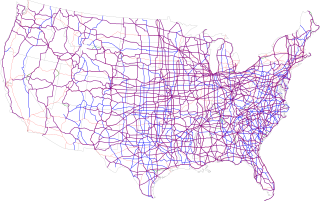
The United States Numbered Highway System is an integrated network of roads and highways numbered within a nationwide grid in the contiguous United States. As the designation and numbering of these highways were coordinated among the states, they are sometimes called Federal Highways, but the roadways were built and have always been maintained by state or local governments since their initial designation in 1926.

The Lincoln Highway is one of the first transcontinental highways in the United States and one of the first highways designed expressly for automobiles. Conceived in 1912 by Indiana entrepreneur Carl G. Fisher, and formally dedicated October 31, 1913, the Lincoln Highway runs coast-to-coast from Times Square in New York City west to Lincoln Park in San Francisco. The full route originally ran through 13 states: New York, New Jersey, Pennsylvania, Ohio, Indiana, Illinois, Iowa, Nebraska, Colorado, Wyoming, Utah, Nevada, and California. In 1915, the "Colorado Loop" was removed, and in 1928, a realignment routed the Lincoln Highway through the northern tip of West Virginia. Thus, there are 14 states, 128 counties, and more than 700 cities, towns, and villages through which the highway passed at some time in its history.

National Old Trails Road, also known as the Ocean-to-Ocean Highway, was established in 1912, and became part of the National Auto Trail system in the United States. It was 3,096 miles (4,983 km) long and stretched from Baltimore, Maryland, to California. Much of the route follows the old National Road and the Santa Fe Trail, following its decommission it later became the Western portion of U.S. Route 66.
State Road 80 (NM 80) is 32.416-mile-long (52.168 km) north–south state road in southwestern New Mexico, between the Arizona state line near Rodeo and Interstate 10 (I-10) at Road Forks. Lying entirely within Hidalgo County, New Mexico, it is the only section of the old U.S. Route 80 (US 80) in New Mexico which still retains its number. The route was re-designated NM 80 in 1989. This is the reason why NM 80 has an even number designation despite the highway being north/south. From the south, SR 80 acts as a continuation of NM 80 into Arizona.
The Arrowhead Trail or Arrowhead Highway was the first all-weather road in the Western United States that connected Los Angeles, California with Salt Lake City, Utah by way of Las Vegas, Nevada. Built primarily during the auto trails period of the 1910s, prior to the establishment of the United States Numbered Highway System, the road was replaced in 1926 by U.S. Route 91 (US 91) and subsequently Interstate 15 (I‑15). Small portions of the route in California, Nevada and Utah are sometimes still referred to by the name, or as Arrow Highway.

The Midland Trail, also called the Roosevelt Midland Trail, was a national auto trail spanning the United States from Washington, D.C., west to Los Angeles, California and San Francisco, California. First road signed in 1913, it was one of the first, if not the first, marked transcontinental auto trails in America.

U.S. Route 2 (US 2) is a part of the United States Numbered Highway System that is split into two segments. Its eastern segment runs from Rouses Point, New York, to Houlton, Maine. In Vermont, US 2 extends 150.518 miles (242.235 km) from the New York state line in Alburgh to the New Hampshire state line in Guildhall. West of Vermont, US 2 continues into New York for another 0.87 miles (1.40 km) to an intersection with US 11 in Rouses Point. US 2 passes through the cities of Burlington and Montpelier as it traverses the state. The highway parallels Interstate 89 (I-89) between these two cities. The Burlington to Montpelier route was first laid out as a toll road in the early 19th century. It was later incorporated into the transcontinental auto trail known as the Theodore Roosevelt International Highway in 1919 before being designated as part of US 2 in 1926.

U.S. Route 50 (US 50) is a transcontinental highway in the United States, stretching from West Sacramento, California, in the west to Ocean City, Maryland, on the east coast. The Nevada portion crosses the center of the state and was named "The Loneliest Road in America" by Life magazine in July 1986. The name was intended as a pejorative, but Nevada officials seized it as a marketing slogan. The name originates from large desolate areas traversed by the route, with few or no signs of civilization. The highway crosses several large desert valleys separated by numerous mountain ranges towering over the valley floors, in what is known as the Basin and Range province of the Great Basin.

U.S. Route 50 (US 50) is a transcontinental United States Numbered Highway, stretching from West Sacramento, California, in the west to Ocean City, Maryland, in the east. The California portion of US 50 runs east from Interstate 80 (I-80) in West Sacramento to the Nevada state line in South Lake Tahoe. A portion in Sacramento also has the unsigned designation of Interstate 305. The western half of the highway in California is a four-or-more-lane divided highway, mostly built to freeway standards, and known as the El Dorado Freeway outside of downtown Sacramento. US 50 continues as an undivided highway with one eastbound lane and two westbound lanes until the route reaches the canyon of the South Fork American River at Riverton. The remainder of the highway, which climbs along and out of the canyon, then over the Sierra Nevada at Echo Summit and into the Lake Tahoe Basin, is primarily a two-lane road.

U.S. Route 50 (US-50) in Utah crosses the center of the state. The highway serves no major population centers in Utah, with the largest city along its path being Delta. Most of the route passes through desolate, remote areas. Through the eastern half of the state the route is concurrent with Interstate 70 (I-70). US-50 both enters and exits Utah concurrent with US-6, however the two routes are separate through the center of the state.

The Yellowstone Trail was the first transcontinental automobile highway through the upper tier of states in the United States, established on May 23, 1912. It was an Auto Trail that ran from the Atlantic Ocean in Plymouth, Massachusetts, through Montana to Yellowstone National Park in Wyoming, to the Pacific Ocean in Seattle, Washington. The road slogan was "A Good Road from Plymouth Rock to Puget Sound".

The Victory Highway was an auto trail across the United States between New York City and San Francisco, roughly equivalent to the present U.S. Route 40. It was created by the Victory Highway Association, which was organized in 1921 to locate and mark a transcontinental highway to be dedicated to American forces who died in World War I. A series of Victory Eagle sculptures were planned to mark the route, although only a few were actually built and placed.

K-55 is a 12.049-mile-long (19.391 km) west–east state highway in the U.S. state of Kansas. The highway's western terminus is at U.S. Route 81 (US-81) roughly 11 miles (18 km) north of Wellington and the eastern terminus is at K-15 in Udall. It passes through the city of Belle Plaine.
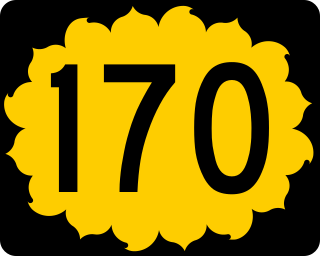
K-170 is a 21.759-mile-long (35.018 km) state highway in the U.S. State of Kansas. K-170's western terminus is at K-99 about 12 miles (19 km) north of Emporia, and the eastern terminus is at K-31 on the west side of Osage City, a mile south of the K-31 intersection with U.S. Route 56 (US-56). K-170 provides access, via county roads, to Lyons County State Fishing Lake.
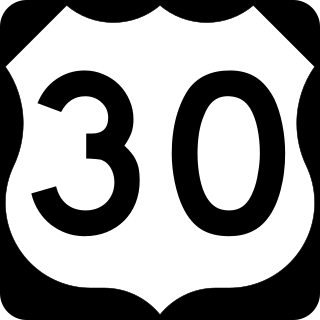
U.S. Route 30 (US 30) runs northwest–southeast across the southern half of lower Idaho for 455.481 miles (733.026 km). US 30 enters the state from Oregon across the Snake River in Fruitland and exits into Wyoming east of Dingle. US 30 runs through the large population centers of Boise, Twin Falls, and Pocatello, as well as a plethora of smaller communities from Fruitland to Montpelier. The Thousand Springs Scenic Byway is a picturesque section of US 30 in southern Idaho between the towns of Bliss and Buhl, dipping down into the Hagerman Valley and a canyon of the Snake River.

Oliver Parker Fritchle was an American chemist, storage battery innovator, and entrepreneur with electric vehicle and wind power generation businesses during the early twentieth century. His initial battery patent was awarded in 1903 and by 1904 he had established what was to become the Fritchle Automobile & Battery Company in Denver, Colorado. He was an early adaptor and developer of significant automotive technologies, such as regenerative braking and hybrid drivetrains, that did not reemerge on production vehicles of major car companies until late in the twentieth century.
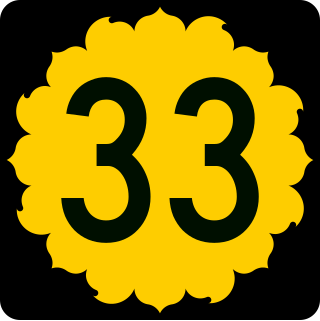
K-33 is an approximately 10.4-mile-long (16.7 km) north–south state highway in the U.S. state of Kansas. K-33's southern terminus is at K-68 in rural Franklin County east of Ottawa and the northern terminus is at U.S. Route 56 (US-56) in Douglas County, east of Baldwin City and southwest of Kansas City. K-33 provides an important link between US-56 and K-68 to Interstate 35 (I-35) and US-50 in Wellsville. K-33 is a two-lane rural highway for most of its length, except for the section within Wellsville.

U.S. Route 80 was a major transcontinental highway in the U.S. state of New Mexico from November 11, 1926, to October 12, 1991. Nationally, US 80 stretched from San Diego, California to Tybee Island, Georgia, going through southern New Mexico from El Paso, Texas, through the towns of Las Cruces, Deming and Lordsburg before entering Arizona. US 80 was a modest 191 miles (307 km) long and was eventually replaced by Interstate 10 leading to the complete removal of US 80 in New Mexico. State Road 80 is a remnant of this route.

K-20 is a 37.21-mile-long (59.88 km) west–east state highway in the northeastern part of the U.S. state of Kansas. It connects U.S. Route 75 (US-75) in the Kickapoo Nation Indian Reservation with K-7 southwest of Troy. Along the way, K-20 intersects several major highways, including U.S. Route 159 in Horton, and overlaps U.S. Route 73 from Horton to south of Everest. Northeast of Denton, the highway intersects K-120, which travels north to Severance and Highland. K-20 travels through mostly rural farmlands and is a two-lane highway its entire length.
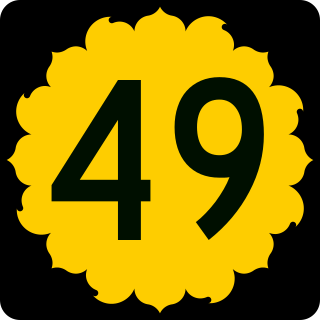
K-49 is a 35.354-mile-long (56.897 km) north–south state highway in the U.S. state of Kansas. K-49 begins at U.S. Route 81 (US-81) in Caldwell, and runs north to K-42 in Viola. Along the way, K-49 has a brief overlap with US-160 south of Conway Springs. The majority of the route exists in Sumner County, with only a mile existing in Sedgwick County.




















